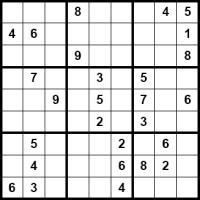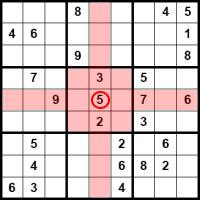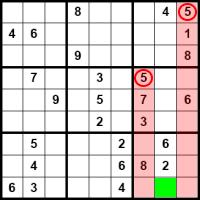Sudoku - the rules ↥

A Sudoku consists of 9 x 9 squares, which are additionally divided into 3 x 3 blocks with 3 x 3 squares.
Each row, column and block contains all the numbers from 1 to 9 exactly once.
Some of the cells already contain numbers.
The degree of difficulty of a Sudoku can depend on the number of numbers given or on the position of the given numbers.
In a Sudoku there must only be one possible solution, and it must be possible to find it logically!
1 to 9 only once each ↥

As each number may only occur once per row, column and block, the positions for other numbers of this value can be excluded using predefined numbers.
The example opposite shows which fields the 5 exactly in the middle blocks for further 5s. Under no circumstances can there be another 5 in the red area!
In this way, you can gradually exclude numbers for the positions that go there
Scan Sudoku ↥

Scanning is a technique for solving a Sudoku. In our example sudoku, you can clearly determine the position of the 5 in the bottom right block (marked in green) using the given numbers. All other fields in the block are either already filled or are blocked by a 5 in the respective column. Also, no other number can be in the field, as there must be a 5 in this block, and this is only possible in this field.
In this way, you can gradually fill more and more fields by repeating this scanning process for all numbers.
Another technique is to count which numbers are still missing in a column, a row or a block and then exclude the positions of these numbers.
An application of these solution techniques is demonstrated in the Sudoku guide.
Sudoku aids ↥
Especially with more difficult Sudoku puzzles, you must somehow note which number is excluded for a field or which number would be possible there. Depending on the size of the Sudoku, such notes can fit directly into the cells or you can use an extra piece of paper to write down this information.
Clockwise stroke method ↥

A fairly space-saving method for remembering possible positions for a number is the clockwise stroke method. This involves making a clockwise mark for possible numbers in the corresponding fields on the outside. For the 5, you make a dot in the middle. If it turns out in the further course of the solution that you can exclude another number, you can simply cross out the mark again.
Another aid when scanning is to use strips of paper to cover the fields that are blocked by the number. This means that the scanning process does not have to be carried out completely in your mind.
At Sudoku for printing you can download PDFs with Sudoku, print them out and then of course also use the clockwise stroke method there.
Negative grid ↥

A negative grid can also be used. Here, each free field is divided into 9 sub-areas, each sub-area represents a possible number. For the numbers that can be excluded there, a mark is inserted in the sub-area for the number, e.g. a slash.
Of course, this method can be refined so that, for example, a cross is made for numbers to be excluded and a slash for possible numbers.
Everyone has to decide for themselves which tools to use to solve the Sudoku and how to modify them. The Sudoku Online offers help numbers in two colors.
( 587 Words = 3298 Characters)